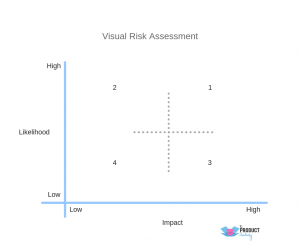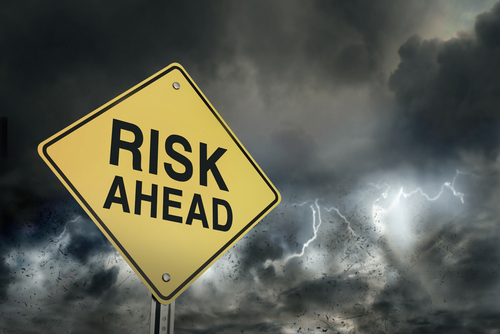This is the 4th in a series of blogs on how to design plans, where the plan itself helps you succeed. The first blog outlines what makes a plan a good plan, rather than just any old plan. Then there are more detailed blogs on each of the 5 key components of a good plan. You can read about goal setting here and the importance of milestones here. This blog is all about the realistic risks your plan will almost certainly have. In fact, if there are no risks, then there is a distinct possibility your goals and plan aren’t ambitious enough 🙂
When I work with clients, 9 times out of 10, this is the part they want to rush past. I’m just as guilty of it myself when looking at my own plans. Sometimes, I think it’s because my clients and I are so excited to move forward, they /I can’t comprehend anything getting in the way of it. After spending so much time really being sure the goals are the right goals and, that we have an incredible plan to get there, who wants to start thinking of the gritty, grimy stuff that could slow us down or stop us in our tracks??
The word “Risks” itself can also sound scary and fatalistic. This can also mean that we shy away from looking at risks at all, simply because it’s less worrying to convince ourselves there are no risks and carry on regardless – or to tell ourselves the ones that we can see, are so unlikely we don’t need to worry about them. Or the age-old procrastination thing again…we have no idea what to do about them anyway, so we put off thinking about them. Perpetually.
Unfortunately, those risks have a tendency to loom in our peripheral vision the whole time. If the risk doesn’t come to life, then we breath a sigh of relief and congratulate ourselves for not getting carried away worrying about something that was never going to happen. But….
If the risk does come to life, then we kick ourselves. The internal recriminations start, usually with something like “I just had a feeling this would happen”. Soon to be followed by “Why didn’t I do something about it before?”.
All of this peripheral looming and internal recriminating takes up brain space and stopping us having 100% of our brain working on our plans and goals. For those risks that do come to life, we are now also using up even more brain space plus time, money and other resources dealing with the situation we now find ourselves in. We are probably now also way off track with our plans and goals.
Equally, if we were to freak out about every potential risk and try to come up with precise solutions to all of them, we’d soon find ourselves going nowhere. Spinning on the spot, anxiously awaiting for the other shoe to drop isn’t very productive either.
So what’s the answer?
The clue is in the title to the blog. We need to assess the realistic risks that we may well encounter as we progress through our plan.
What is a risk assessment?
Every single day, we make risk assessments continually, without stopping to consider that we are carrying out a risk assessment. By the time we’re adults, most of us know not to do the most dangerous stuff without even thinking about it. We don’t stop to think about looking both ways when we cross the road. If you drive a car, almost every decision you make is a risk assessment. Is it safe for me to overtake? Do I need to come to a complete stop at the roundabout?
Each and every time, we are making an evaluation of how likely is it that we will be involved in an accident and, how bad would that accident be?
A really good example is driving down a residential street with a car parked on one side of the road and a car coming in the other direction on the opposite side. There is a gap that you can fit down. But can you both fit down it simultaneously? I guarantee most of us will slow our car down almost as soon as we see the other car. By slowing down, we are reducing the likelihood of an accident and we are also reducing the impact (literally!) of the cars colliding.
As we get closer, now at a slower speed, we are better able to assess the size of the gap, the actions of the other driver and whether we should stop or proceed safely. If the worst should happen and we or the other driver does get it wrong, then we are now facing a minor slow-speed bump rather than a head-on full speed collision.
This is exactly what we are looking to do with a risk assessment within our business plans. We want an early warning of anything up ahead that could cause us a problem. Once we can see it, we can take a small amount of time to assess it which actually decreases the chances of the risk becoming an actual problem.
How do I do a risk assessment of my plan?
At the crux of it, there are really only 3 steps to follow for a risk assessment:
Step 1- Identify the potential risks that could happen
Step 2- Evaluate how likely it is that the risk will happen
Step 3 – Estimate what would be the impact to me, my business and my plan if the risk did happen
Step 1 – Identify the potential risks that could happen
Depending on the size, importance and complexity of your plan, your risk assessment could be a very simple personal assessment or it could be a formal evaluation with inputs from other people. Undertaking your risk assessment in your planning is no different to the risk assessments you do every day. However, you may not have a visual risk you can see right in front of you. We need to look outside and beyond our immediate situation and imagine what could go wrong further ahead – these are the potential risks.
One of the ways, I help clients imagine this is to ask questions around 3 factors that are common to most plans:
- What could stop you or your team having the time to do this?
- What could stop you or your team having the money to do this?
- What could stop you or your team having any other important resources (eg skills, other people’s support, tools etc) to do this?
It’s important at this stage not to dismiss risks out of hand. This is not the evaluation stage. This is the identifying stage. You just want to list as many as possible here. As a general rule though, if you start thinking in terms of religion, politics, philosophy or astrophysics, you can probably stop 🙂
Step 2 – Evaluate how likely it is that the risk will happen
The answer to this will clearly depend on your own unique circumstances but it’s key to remember you are evaluating. You can’t know for certain but you can use your insight and that of the people around you to come up with what you think the likelihood is at this stage.
I personally use 2 very simple methods to work this out.
The absolute simplest is to think in terms of High, Medium and Low risk. Pretty self-explanatory I think and is simply grouping the risks by which seem most likely to happen, which seem least likely to happen and those somewhere in the middle.
Or, if I am working on a bigger plan or project with a lot of risks and/or other stakeholders to involve, I find ranking them in order of likelihood – usually with the help of the beloved yellow sticky note – really helps put them into perspective. “Is this one more or less likely than this one?” can sometimes be a much easier question to answer than thinking of each one in isolation. And if it’s really not clear, you can then use the groupings above within the rankings.
Step 3 – Estimate what would be the impact to me, my business or my plan if the risk did happen
It’s important to know whether you are thinking about whether the impact is to you, your business or your plan. Otherwise, you risk comparing apples and pears. Pick one and use the same one for all of your estimates.
Using the 3 common areas I referred to earlier can help here too. What would be the impact on the time, money or other resources I need to do this? And, again you could do decide to group these in terms of High, Medium or Low or rank them against each other.
Visualising a risk assessment
One of my all-time favourite tools, that I repurpose over and over again is a simple 2-axis chart:

In terms of a risk assessment, on one axis (side) you look at likelihood. On the other you look at impact. And you just pop each of your risks in the appropriate place.
Where each risk lands, gives you a very visual clue whether it falls into our category of realistic risks. Those coming out in the bottom left – low risk, low impact – we probably don’t need to worry about at this stage and we can make them ou Priority 4. Those on the top right however, high risk, high impact – those are the ones we should probably be thinking about before we go any further on our plan. These would be our Priority 1.
Some people ask about the difference between Priority 2 and Priority 3. It comes down to likelihood. We are looking for the realistic risks. Although the impact of risks in Priority 2 is lower than those in Priority 3, we have decided there is a higher chance of them coming to life. Therefore, it would be a more beneficial use of our time to think about those.
Having said that, you quite often end up with a grouping of items around the very middle of the chart. In which case, you might decide that there are some Priority 3 items that are only slightly less likely than some of those in Priority 2 but with a higher impact. You may then decide to adjust your priorities accordingly. At the end of the day, this is YOUR risk assessment and you can decide what you do with it 🙂
Ok, so I know my realistic risks, what on earth do I do about them?
Fear not, this is where contingency planning comes in. I explain what contingency plans are in the first blog in this series – and I’ll be going into a lot more detail about them in the next one, which you can sign up for below!

